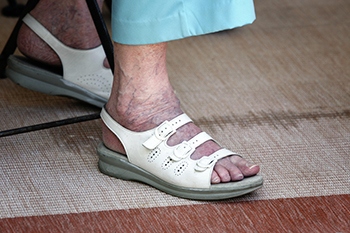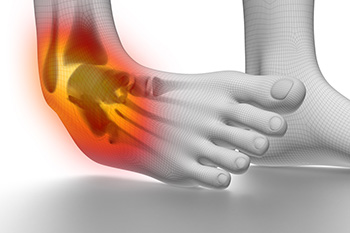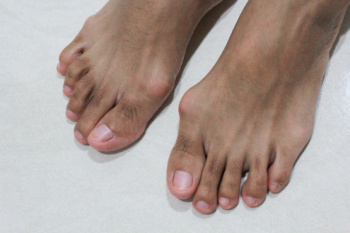Items filtered by date: October 2025
Common Foot Problems in Elderly People

As people age, their feet often experience natural changes that can lead to discomfort and mobility issues. Thinning fat pads reduce cushioning, which can make walking and standing more painful. Osteoarthritis commonly develops, causing joint stiffness and swelling. Reduced circulation may result in cold feet, slow healing, and increased risk of infection. Many elderly individuals also experience decreased pain sensation, which can make it difficult to notice injuries or pressure sores. Regular foot care and attention from a podiatrist can help manage these conditions, improve comfort, and prevent complications. If you or a loved one are experiencing foot pain or changes, it is suggested that you schedule an appointment with a podiatrist who can treat various foot conditions, and guide you on how to maintain healthy, pain-free feet.
If you need your feet checked, contact Robert Dunne, DPM of Lake Washington Foot and Ankle Center. Our doctor will attend to all of your foot and ankle needs and provide you with quality treatment.
Geriatrics and Podiatry
When people age, some common issues that may occur are bone density loss, dry skin, poor circulation, and rough brittle nails. These issues may also affect your foot health if the necessary steps are not taken to alleviate the problems.
It is important to take care of your feet because feet that are injured or diseased can affect your overall health. Having painful feet hinders your ability to do daily activities or may decrease your willingness to do the things that you need to do.
Visiting Your Geriatrician
As we age, health problems become more likely, so it is essential to visit your doctor for check-ups to ensure that you are doing the best you can to take care of your health. It is recommended to check your feet frequently for any possible cuts, bruises, swelling, corns or any other irregularities.
Taking Care of Elderly Feet
Cracked or dry feet can be treated by applying moisturizer often. It is also important not to wear old socks because the older the sock is, the higher the possibility there will be that there is bacteria there. Wear fresh socks and make sure they fit properly.
Proper foot health means that you can have a more active lifestyle and you will not be bogged down by pain. Foot health also leads to good circulation, which is paramount for overall health.
If you have any questions, please feel free to contact our offices located in Melbourne and Palm Bay, FL . We offer the newest diagnostic and treatment technologies for all your foot care needs.
Grades of Ankle Sprains

An ankle sprain occurs when the ligaments that support the ankle are stretched or torn, usually due to twisting or rolling the foot. Ankle sprains are grouped into grades, depending on the severity. Grade 1 symptoms include mild pain, and generally no bruising. A grade 2 sprain consists of moderate pain and joint instability. Additionally, loss of function and range of motion can accompany a grade 3 sprain. Temporary relief can be found by resting the ankle, applying compression with an elastic bandage, and elevating it to reduce swelling. A podiatrist can evaluate the injury, recommend targeted exercises, and provide support to prevent future sprains. If you have sprained an ankle, it is suggested that you promptly consult a podiatrist who can determine the severity and provide effective treatment solutions.
Although ankle sprains are common, they aren’t always minor injuries. If you need your ankle injury looked at, contact Robert Dunne, DPM from Lake Washington Foot and Ankle Center. Our doctor can provide the care you need to keep you pain-free and on your feet.
How Does an Ankle Sprain Occur?
Ankle sprains are the result of a tear in the ligaments within the ankle. These injuries may happen when you make a rapid shifting movement while your foot is planted. A less common way to sprain your ankle is when your ankle rolls inward while your foot turns outward.
What Are the Symptoms?
- Pain at the sight of the tear
- Bruising/Swelling
- Ankle area is tender to touch
- In severe cases, may hear/feel something tear
- Skin discoloration
Preventing a Sprain
- Wearing appropriate shoes for the occasion
- Stretching before exercises and sports
- Knowing your limits
Treatment of a Sprain
In many cases, the RICE method (Rest, Ice, Compression, and Elevate) is used to treat ankle sprains. However, you should see a podiatrist to see which treatment option would work best with your injury. In severe cases, surgery may be required.
It is important to ask your doctor about rehab options after you receive treatment for your injury. Stretching, strength training, and balance exercises may help the ankle heal while also preventing further injury.
If you have any questions, please feel free to contact our offices located in Melbourne and Palm Bay, FL . We offer the newest diagnostic and treatment technologies for all your foot care needs.
Understanding Achilles Tendon Rupture in Basketball Players

An Achilles tendon rupture is a complete tear of the strong tendon that connects the calf muscles to the heel bone. This injury often occurs during explosive movements like jumping or sudden direction changes, making basketball players especially vulnerable. A rupture can cause intense pain, swelling, difficulty walking, and a sudden loss of strength in the ankle, impacting athletic performance and daily activities. A podiatrist can provide a thorough diagnosis, advanced treatment options, and guide patients through surgical or non-surgical recovery plans to restore strength and mobility. Prompt care is essential for full recovery and return to play. If you have sustained an Achilles tendon injury, it is suggested that you contact a podiatrist who can offer effective treatment solutions, helping you to resume your daily and sporting activities.
Achilles tendon injuries need immediate attention to avoid future complications. If you have any concerns, contact Robert Dunne, DPM of Lake Washington Foot and Ankle Center. Our doctor can provide the care you need to keep you pain-free and on your feet.
What Is the Achilles Tendon?
The Achilles tendon is a tendon that connects the lower leg muscles and calf to the heel of the foot. It is the strongest tendon in the human body and is essential for making movement possible. Because this tendon is such an integral part of the body, any injuries to it can create immense difficulties and should immediately be presented to a doctor.
What Are the Symptoms of an Achilles Tendon Injury?
There are various types of injuries that can affect the Achilles tendon. The two most common injuries are Achilles tendinitis and ruptures of the tendon.
Achilles Tendinitis Symptoms
- Inflammation
- Dull to severe pain
- Increased blood flow to the tendon
- Thickening of the tendon
Rupture Symptoms
- Extreme pain and swelling in the foot
- Total immobility
Treatment and Prevention
Achilles tendon injuries are diagnosed by a thorough physical evaluation, which can include an MRI. Treatment involves rest, physical therapy, and in some cases, surgery. However, various preventative measures can be taken to avoid these injuries, such as:
- Thorough stretching of the tendon before and after exercise
- Strengthening exercises like calf raises, squats, leg curls, leg extensions, leg raises, lunges, and leg presses
If you have any questions please feel free to contact our offices located in Melbourne and Palm Bay, FL . We offer the newest diagnostic tools and technology to treat your foot and ankle needs.
Living With Bunions

A bunion is a bony bump that develops at the base of the big toe when the joint shifts out of alignment. Over time, the toe drifts toward the others, creating pressure, swelling, and discomfort that can make walking or wearing shoes difficult. Genetics, flat feet, arthritis, or years of wearing tight footwear can all contribute to their development. While bunions often progress slowly, they can interfere with mobility, if left unaddressed. Wearing wide shoes, adding protective padding, and using custom orthotics may reduce pressure and ease pain. Anti-inflammatory medication can also bring relief during flare-ups. In severe cases, surgery may be considered to correct the alignment. Taking steps early helps preserve comfort and function. If you are experiencing ongoing pain or changes in your big toe joint, it is suggested that you consult a podiatrist for guidance and appropriate treatment options.
If you are suffering from bunions, contact Robert Dunne, DPM of Lake Washington Foot and Ankle Center. Our doctor can provide the care you need to keep you pain-free and on your feet.
What Is a Bunion?
A bunion is formed of swollen tissue or an enlargement of boney growth, usually located at the base joint of the toe that connects to the foot. The swelling occurs due to the bones in the big toe shifting inward, which impacts the other toes of the foot. This causes the area around the base of the big toe to become inflamed and painful.
Why Do Bunions Form?
Genetics – Susceptibility to bunions are often hereditary
Stress on the feet – Poorly fitted and uncomfortable footwear that places stress on feet, such as heels, can worsen existing bunions
How Are Bunions Diagnosed?
Doctors often perform two tests – blood tests and x-rays – when trying to diagnose bunions, especially in the early stages of development. Blood tests help determine if the foot pain is being caused by something else, such as arthritis, while x-rays provide a clear picture of your bone structure to your doctor.
How Are Bunions Treated?
- Refrain from wearing heels or similar shoes that cause discomfort
- Select wider shoes that can provide more comfort and reduce pain
- Anti-inflammatory and pain management drugs
- Orthotics or foot inserts
- Surgery
If you have any questions, please feel free to contact our offices located in Melbourne and Palm Bay, FL . We offer the newest diagnostic and treatment technologies for all your foot care needs.

